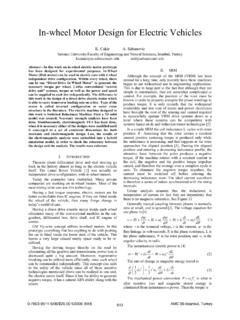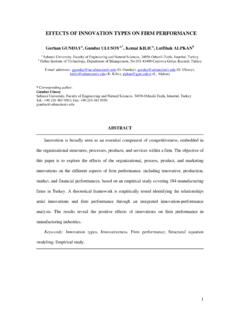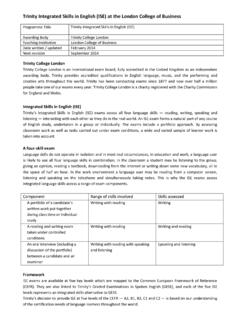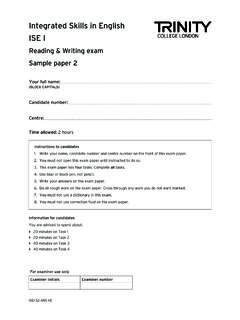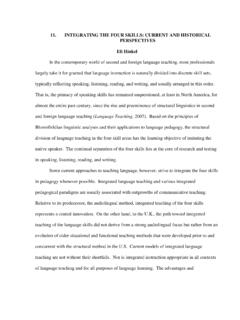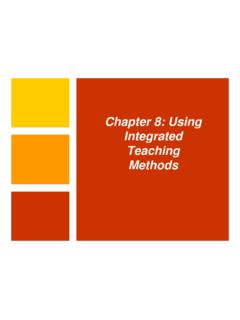Transcription of Cambridge Academic English - Sabancı Üniversitesi
1 Cambridge Academic English : An integrated skills course for EAP B2 Upper Intermediate Student s Book, Teacher s Book, Audio CD and DVD Adam Simpson For those who have had the experience of preparing students for Academic study using a general English course book, the notion of a series that progressively aims to develop the kinds of skills necessary for tertiary study in an English -medium institution should be immediately compelling. With a market existing for a series, Cambridge s three-level (B1+ to C1) integrated skills course for higher education students at university or on foundation courses has an audience ready and waiting for books that deliver the goods. The good news is that, in designing this book I m talking in particular about the Upper Intermediate B2 volume here - specifically for students at university and on EAP foundation courses, this integrated skills course has given due attention to the type of language and the actual Academic skills essential for successful university studies across a number of disciplines.
2 Indeed, in promoting this new series, author Martin Hewings makes note of the point that there isn t any specific vocabulary or grammatical structures which are the sole property of Academic English , merely that certain words and structures appear with greater frequency in an Academic environment. It is these frequently used structures and this common lexis which form the first main focus and which are effectively dealt with - in this book. The second, equally well covered, focus is perhaps what differentiates EAP from general English : the contexts in which the language occurs . Lectures and seminars aren t situations in which people find themselves in general, everyday life, nor are people required to write essays outside of Academic settings. It is therefore not surprising to find much attention given to developing the skills necessary for the key receptive and productive aspects of EAP. In terms of book units, each follows a standard progression.
3 Starting with receptive input a reading followed by a listening the student is guided through the various skills that are useful for dealing with lengthy Academic texts and lectures. While each unit starts out with reading and then listening, the input material is exploited in a way that enables the building up of a range of different skills . Unit 1, for example, gets the student to look at old classics like skimming, scanning and inferring the meaning of unknown words, while by Unit 8 the student is being asked to understand figures and tables as well as understanding the significance of references. The latter part of each unit moves the student from receptive to productive skills , building up skills such as delivering a presentation. There is also a separate section of each unit dealing with the grammar and vocabulary pertinent to the particular skills that the unit has focused on. In terms of organization, this pattern makes the book easy to follow, with each section given a standard color coding so that the learner can immediately recognize what it is they are working on at any given time.
4 All in all, this is an easy to navigate book which has been well planned out. While the progression of units is ostensibly logical, it doesn t negate the possibility of using each unit as and when it might fit into a curriculum prioritizing the skills in a different order to how they are presented in the book. Basically, this flexible structure enables modular use of each unit, so teachers can focus on specific skills rather than pursuing the integrated approach. If there is a criticism that can be leveled at this book it would be a very general one: it appears to be very much your typical TEFL coursebook. At first glance, it follows the conventions of the most well-known titles in world of ELT publishing. Nevertheless, such a criticism is unjustified, given the obvious care that has gone into creating a resource for a very specific target market. A general ELT coursebook this most certainly isn t.
5 Indeed, this has been clearly designed specifically for students at university and on foundation courses. Other aspects of the book further reinforce the notion that much thought has gone into providing a resource that will be as useful as possible for the target consumers. Firstly, there is recognition of the fact that Academic study requires not only a lot of solo work but also adequate collaborative skills for working in groups. This has been addressed in the 'Study tips', which facilitate the development independent learning and group work skills . Secondly, there are points in each unit in which the learner is asked to look at the skill they have practiced and apply it to their own area of study. Given that this is an EAP book rather than an ESP volume, this seems like a fair compromise and one which the particular teacher can work on in their Academic setting, according to the given context. Finally, there is recognition that lectures are the one big part of Academic life that causes the greatest problems for non-native university students.
6 This has been addressed by the addition of five Lecture skills units interspersed among the other units. This extra focus on how to deal with lectures is a key part of the appeal of this book, as it focuses on such things as understanding the relationship between different parts of a lecture and examining how a speaker makes references. One thing I particularly liked about the audio and visual materials are that they come across as being genuinely authentic. Rather than solely hearing and watching recordings of native speakers delivering the receptive input, we are treated to academics from all over the world, many of whom are using English as a second language. Consequently, we are met with actual authenticity, with the occasional preposition missed or other such minor infraction in language use. This is a book that therefore presents a realistic view of what learning will be like for a learner studying in an English medium context.
7 Great care has been taken to choose material, with the fact that the choice of language presented was informed by the Cambridge Academic Corpus and the Academic Word List immediately evident. This is no bad thing, indeed it is one of the main pluses of this book that it provides so solid a foundation in the kind of language that Academic learners will encounter. The promotional blurb suggests that the Audio CD and the DVD include extensive materials with authentic Cambridge University lectures and interviews with university students which provide the basis for developing listening, note-taking, discussion and other skills specific to an Academic context. It should perhaps be noted that by extensive they mean covering the full range of Academic skills , rather than focusing on full-length lectures. Consequently, those among us who view getting learners to listen to complete lectures as being the best way of building up a student s ability to cope when confronted with such lectures will find themselves needing to supplement this book with their own resources.
8 The teacher s book is also extensive, equal in length to the student s book. While it generally follows a traditional linear style, describing how to present each task in the book in turn, it nevertheless allows for some flexibility with an impressive number of optional extra tasks which allow the teacher to take the teaching of the unit into different directions as and when necessary. There are also a good number of photocopiable classroom activities, as well as suggestions for suitable homework assignments. Importantly, the teacher s book doesn t scrimp when it comes to offering support in the explanation of the grammar contained in each unit. CUP has clearly seen a niche in the market for a general purpose book for EAP. All in all, author Martin Hewings and course consultant Michael McCarthy have delivered the goods with Cambridge Academic English : An integrated skills course for EAP.
9
